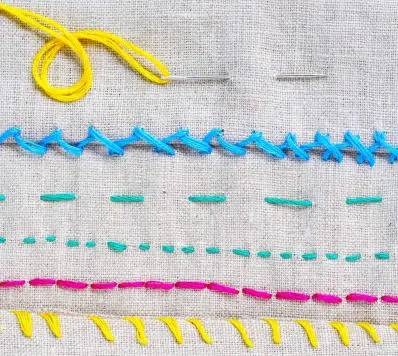Different Types Of Stitches | 9 Basic Hand Sewing Stitches:
Jump To:
Here are the different types of stitches. I’m sure you must’ve straight/running stitched at least once in your lifetime just to fulfill the urgency of wearing a particular little-torn dress for that particular occasion. The running stitch is the simplest among all types of hand stitches. We’ll learn different types of hand stitches here with steps. Check out how to sew to start your first stitch. You can also get into different types of embroidery stitches and then some simple embroidery designs easily by learning the following types of hand stitches first.
Hand stitches are very much useful even when you’ve got the best sewing machine. There are different types of temporary stitches and permanent stitches by hand. Sometimes in urgency and sometimes for the better look of the garment, such as seaming stitches, which might not work well on a sewing machine. Then comes the use of different types of stitches by hand.
Another usually used stitch is the backstitch. The backstitch is the strongest among the types of hand stitches that are most adaptable and permanent hand stitches. It’s also a bulk-free knot replacement for the beginnings and endings of hand-sewn seams.
The various types of hand stitches are used for a variety of purposes, such as stitching seams, overcast heavy garments, etc. Let’s get into the basic types of hand stitches.
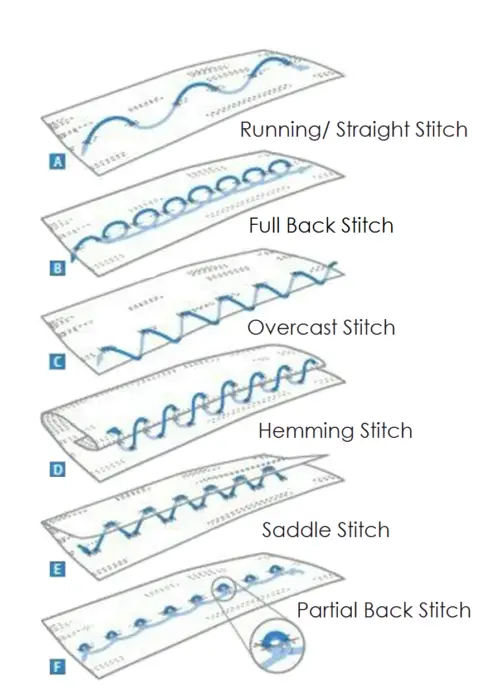
Basic Types Of Hand Stitches | Different Types Of Stitches:
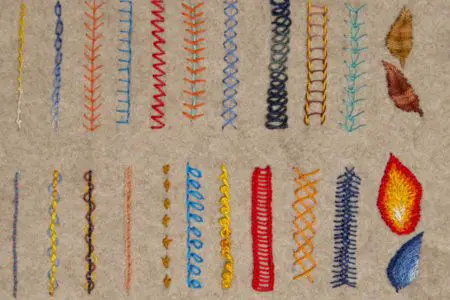
Many home-sewn and custom-made garments continue to have the types of hand stitches used primarily as finishing techniques (hemming, securing fasteners, etc.). Thus, knowing and understanding the proper types of stitches to use is important to the item’s appearance.
1. Straight Stitch / Running Stitch:

The running stitch/straight stitch is the most basic of the hand-sewing stitches. It has many variations according to the requirement.
While running stitch, the needle is passed in and out of the fabric in a straight line creating a series of evenly spaced stitches. This stitch is often used for temporary sewing, basting, or gathering fabric.
Uses:
- Gathering
- Mending
- Tucking
Procedure:
- Insert your threaded needle from the wrong side upwards.
- Insert it down into the fabric according to the marked design
- Bring the thread back up and repeat.
2. Basting/Tacking Stitch:

It is the same as the running stitch but with longer stitches (between 1/4 and 1/2 inches). You can do it straight also instead of slanting as in running stitch.
Uses:
- Tacking
- Holding seam
- It can be used as a temporary stitch
Procedure:
-
- Pierce your threaded needle from the wrong side upwards.
- According to the marked design, pierce it down into the fabric with longer stitches up to 1/4 inch to 1/2 inch.
- Bring the thread back up and repeat.
Today, we tend to pin-baste more than hand bastes our garments and projects, but hand-basting can still be useful, especially with both lightweight (silk and chiffon) and heavyweight (leather and Melton) wools.
3. Backstitch:

A hand-sewn backstitch is a strong, reliable stitch. Before sewing machines, all clothes were built layer upon layer of backstitches.
Back stitch is a strong and durable stitch commonly used for seams and hems. You’ll be sewing two stitches forward and one stitch backward, creating a solid line of stitching with no gaps.
Uses:
- Attach fabrics
- Outline shapes for embroidery designs
- Writing
Procedure:
- Working from left to right, take a small stitch
- Then insert the needle at the end of the previous stitch, bringing it out beyond the point where the thread emerges.
- Continue, always inserting the needle at the end of the previous stitch.
4. Catch stitch (Cross-Stitch):

You can use this stitch to finish hems with fabric that doesn’t fray and to tack facing invisibly.
Uses:
- Hem
- Seam Allowances
- Lining Garments
Procedure:
- Working from left to right, take tiny stitches on the hem.
- Then take a tiny stitch on the garment.
They will appear as crosses on the wrong side and small stitches on the right, as seen in the image.
5. Slip Stitch (Blind stitch):

This is the most used stitch for hems and other finishes. It’s almost invisible and clean when it’s done right. A nearly invisible stitch used for hemming, sewing fabric layers together without the stitches being visible on the right side. The needle catches only a few threads from each layer of fabric, keeping the stitches hidden.
Uses:
- Join two pieces with stitch thread being invisible
- Hem
Procedure:
- Bring the needle through the fold of the hem.
- Pick up a thread of fabric at the same point.
- Make the stitches about a 1/2 inch apart and fairly loose.
A slip stitch is a common hemstitch and is used when you don’t want visible stitches.
6. Blanket Stitch (Buttonhole Stitch):

If you want to sew eyelets or buttonholes by hand, learn the buttonhole stitch. Also, a decorative stitch for finishing the edges of blankets, felt, or fabric. It forms a series of looped stitches, resembling a line of “V” shapes, often used for appliqué work.
Uses:
- Enclose the raw edges of heavy fabrics
- Decorative stitch
Procedure:
- Secure the thread on the wrong side of the fabric, and insert the needle from back to front through the fabric 1/8 inch from the edge.
- Wrap the working head around behind the eye end of the needle, then behind the point.
- Pull the needle through, bringing the knot to the fabric edge.
- Continue, making closely spaced stitches and knots.
The eyelet version is worked in a circle, with the wrapped edge to the inside; the blanket stitch variation has at least a 1/4 inch spacing between stitches.
7. Fell Stitch:
Fell stitch is known as appliqué stitch, which is one layer of fabric (generally a folded or selvage edge) that is stitched to another. It’s quick, strong, and flexible-the piece sewn on with a fell stitch can move somewhat like a hinge, and that makes it good for installing linings.
Uses:
- Applique seam
- Sew lace-either as appliqués or appliqué seams.
- Millinery work and clothing such as attaching hat bodies to brims and attaching hatbands to hats.
The stitches themselves typically sit 90 degrees to the edge, or they can be angled slightly.
Procedure:
- Emerge on the folded edge. The stitch should be about 1mm away from the fold.
- Insert the needle directly into the fabric next to the fold.
- Run it diagonally so that it emerges beyond the first stitch.
- Pull the stitch closed.
Sew the stitches between 1⁄8 to 1⁄4 inch apart.
8. Overcast Stitch:
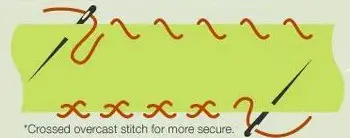
An overcast stitch is one of several types of hand stitches. The purpose is to prevent the unraveling of the fabric.
You can secure the fabric’s edge with an overcast stitch by wrapping the thread around it, to prevent fraying and adding a clean, finished look. This technique is particularly useful for finishing the edges of seams, hems, or small fabric pieces in projects like quilting, sewing garments, or making crafts.
Uses:
- Enclose raw edges of a fabric
9. Whip Stitch:

The whipstitch by definition is a simple stitch used in both sewing and crocheting. It is a visible, continuous, and diagonal stitch.
Uses:
- Quilting
- Appliqué making
- Closing the sides of pillows and cushion
- Making jeans garments
- Hemming the sides of carpets.
It is usually used to sew together two separate pieces of material with flat edges in both practices. When used on crocheted works, the whipstitch is nearly invisible. For sewn works, the stitch is more visible but can be masked.
The whip stitch provides a sturdy and flexible seam, making it suitable for various sewing projects, especially when you want a quick and straightforward method to join two pieces of fabric together.
There will be many times when a hand stitch does your work than a sewing machine. I hope these basic types of hand stitches help you get through the situations easily.
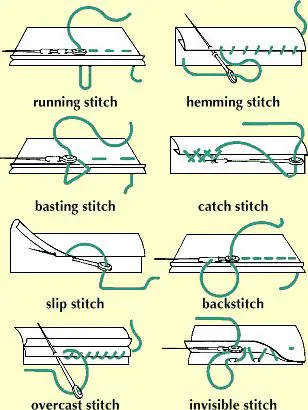
What are examples of decorative stitches?
Some of the most commonly used decorative stitches which are also being used to add value in a range of apparel are:
- Zigzag Stitch.
- Satin Stitches – An embroidery stitch used to fill in shapes or create solid blocks of color. It involves closely spaced straight stitches worked side by side to create a smooth and satin-like appearance.
- Blanket Stitch.
- Overedge Stitch.
- Fagoting.
- Picoetta Stitch.
- Feather Stitch: Fly or Feather Stitches.
What is the strongest stitch by hand?
backstitch. A backstitch is one of the strongest hand-sewing stitches. The backstitch gets its name because the needle goes into the fabric behind the previous stitch. On the contrary, with a running stitch, the needle simply passes through the fabric an even distance in front of the previous stitch.
What is a bullion stitch?
Definition of bullion stitch: a decorative stitch similar to the French knot forming very short bars.
How do you do simple hand stitches?
Thread a hand-sewing needle and knot the thread. Stitch through the fabric to the backside, skip a small distance, and stitch back up to the right side. Repeat the stitch in a straight line for the distance needed. Sew one or two stitches in place at the end of the area you want to be basted.
How do you hand sew a durable stitch?
What stitch is the simplest permanent stitch?
The running stitch is the most basic and most commonly used stitch, in which the needle and thread simply pass over and under two pieces of fabric. It’s exactly the same as a basting stitch, except it is sewn more tightly to create a secure and permanent bind.
